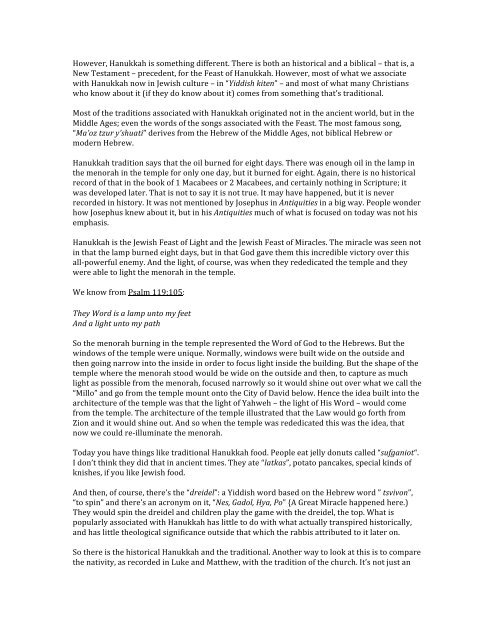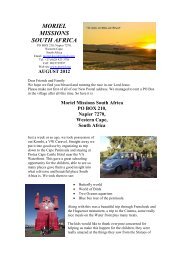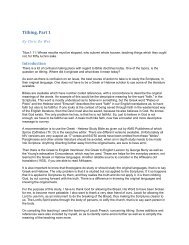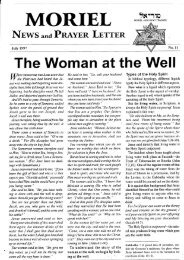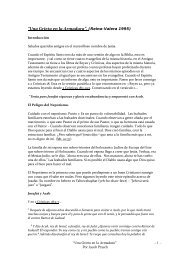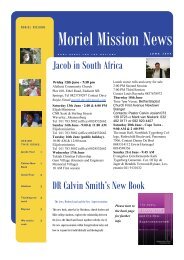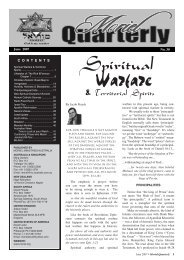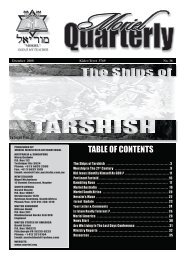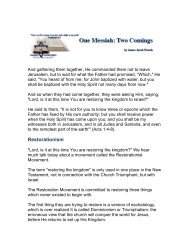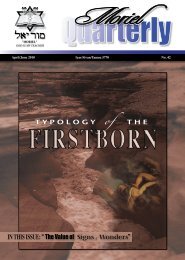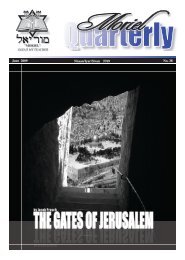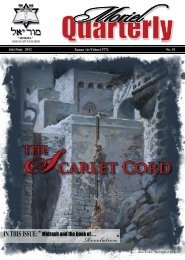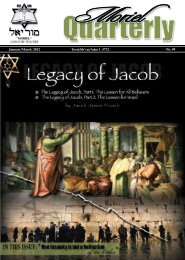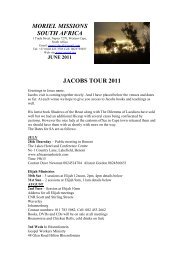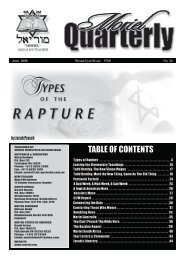Introduction The Traditional Aspect - Moriel Ministries
Introduction The Traditional Aspect - Moriel Ministries
Introduction The Traditional Aspect - Moriel Ministries
You also want an ePaper? Increase the reach of your titles
YUMPU automatically turns print PDFs into web optimized ePapers that Google loves.
However, Hanukkah is something different. <strong>The</strong>re is both an historical and a biblical – that is, a New Testament – precedent, for the Feast of Hanukkah. However, most of what we associate with Hanukkah now in Jewish culture – in “Yiddish kiten” – and most of what many Christians who know about it (if they do know about it) comes from something that’s traditional. Most of the traditions associated with Hanukkah originated not in the ancient world, but in the Middle Ages; even the words of the songs associated with the Feast. <strong>The</strong> most famous song, “Ma’oz tzur y’shuati” derives from the Hebrew of the Middle Ages, not biblical Hebrew or modern Hebrew. Hanukkah tradition says that the oil burned for eight days. <strong>The</strong>re was enough oil in the lamp in the menorah in the temple for only one day, but it burned for eight. Again, there is no historical record of that in the book of 1 Macabees or 2 Macabees, and certainly nothing in Scripture; it was developed later. That is not to say it is not true. It may have happened, but it is never recorded in history. It was not mentioned by Josephus in Antiquities in a big way. People wonder how Josephus knew about it, but in his Antiquities much of what is focused on today was not his emphasis. Hanukkah is the Jewish Feast of Light and the Jewish Feast of Miracles. <strong>The</strong> miracle was seen not in that the lamp burned eight days, but in that God gave them this incredible victory over this all-‐powerful enemy. And the light, of course, was when they rededicated the temple and they were able to light the menorah in the temple. We know from Psalm 119:105: <strong>The</strong>y Word is a lamp unto my feet And a light unto my path So the menorah burning in the temple represented the Word of God to the Hebrews. But the windows of the temple were unique. Normally, windows were built wide on the outside and then going narrow into the inside in order to focus light inside the building. But the shape of the temple where the menorah stood would be wide on the outside and then, to capture as much light as possible from the menorah, focused narrowly so it would shine out over what we call the “Millo” and go from the temple mount onto the City of David below. Hence the idea built into the architecture of the temple was that the light of Yahweh – the light of His Word – would come from the temple. <strong>The</strong> architecture of the temple illustrated that the Law would go forth from Zion and it would shine out. And so when the temple was rededicated this was the idea, that now we could re-‐illuminate the menorah. Today you have things like traditional Hanukkah food. People eat jelly donuts called “sufganiot“. I don’t think they did that in ancient times. <strong>The</strong>y ate “latkas”, potato pancakes, special kinds of knishes, if you like Jewish food. And then, of course, there’s the “dreidel”: a Yiddish word based on the Hebrew word ” tsvivon”, “to spin” and there’s an acronym on it, “Nes, Gadol, Hya, Po” {A Great Miracle happened here.) <strong>The</strong>y would spin the dreidel and children play the game with the dreidel, the top. What is popularly associated with Hanukkah has little to do with what actually transpired historically, and has little theological significance outside that which the rabbis attributed to it later on. So there is the historical Hanukkah and the traditional. Another way to look at this is to compare the nativity, as recorded in Luke and Matthew, with the tradition of the church. It’s not just an


